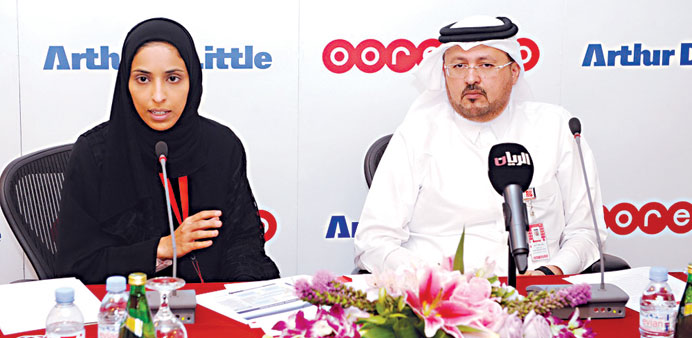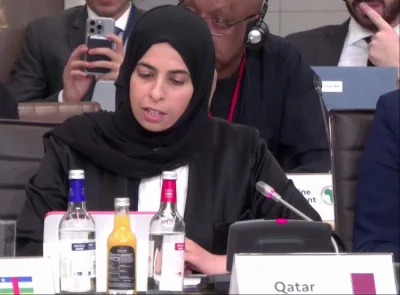Ooredoo chief operating officer (Qatar) Waleed Mohamed al-Sayed and director (Public Relations) Fatima al-Kuwari giving details of the Arthur D Little findings yesterday.
By Pratap John/Chief Business Reporter
In what is seen as the country’s huge success in harnessing modern communication technology, Qatar has topped the world for the “fastest fibre rollout,” a new report by researcher Arthur D Little shows.
In its report “National Fibre Strategies: National economic imperative or just another private industry task?” Arthur D Little said a global study shows Qatar enjoyed one of the fastest nationwide fibre rollouts in the world since the start of deployment in 2011, as judged by the average percentage of homes passed by fibre (33.3% of the total) and the number of homes connected (6.3%) a year.
The study was based on figures from the FTTH Council, data collected from operators and ADL estimates.
The pace of the rollout exceeds that of several highly-developed nations and the United Arab Emirates.
Qatar’s nationwide rollout of fibre, driven by private investment and in partnership with some of the country’s leading businesses, is in line with its ambitious Qatar National Vision 2030, which positions the development of a knowledge-based economy built upon a strong infrastructure foundation as a major strategic priority.
These benefits do not come cheap, as the investment needed is vast. On the back of huge investments made by incumbent operators, some GCC countries are already ranked as global leaders in passing homes/connecting homes to their FTTH networks.
Although this is bringing increasing visibility to the region in global discussions on high-speed broadband infrastructure deployment, the Middle East still has significant challenges to overcome that require intensive government participation. More regional governments are starting to appreciate the role of fibre infrastructure in the national socio-economic development.
“Governments should ensure the right regulation and control so that funding can maximise the economic impact,” states Dr Karim Taga, managing partner and Global Practice leader, ADL TIME practice.
“After 30 years or more of breaking national monopolies, it now seems that too much infrastructure competition is holding back fibre deployment, which in turn is hurting consumers and the wider economy.”
Based on a global market survey, ADL has identified five National Fibre models that governments around the globe have followed to reap the benefits from fibre. ADL has concluded that the most promising fibre strategy models involve a hybrid approach, a combination of free market competition, graded government co-ordination and geographically-targeted public investment open to competitive bid.
“Choosing a National Fibre strategy is about identifying the best model for specific national market conditions and applying that model well,” adds Dr Karim Taga.
The telecom industry, governments and regulators need to move decisively to fibre in order to support future economic growth, the ADL says.
There are clear economic benefits to improving broadband infrastructure; jobs are created and there is a permanent boost to GDP. Ultra-fast broadband also drives critical diversification of economies, as Small and Medium Businesses are among the first to benefit from new services.
“It is no longer possible to modernise and upgrade the copper-based network. Whole fibre or mainly fibre networks are now needed not only for the fastest fixed access services, but also to underpin the micro layer of the latest mobile backhaul networks,” it said.
‘Business Fibre’ soon,
says Ooredoo official
Ooredoo is set to launch “Business Fibre,” the ultra fast fibre optic network targeting Qatar’s businesses, SMEs in particular, by the third quarter of this year.
“We have already rolled out fibre to all business establishments in the country. We are now updating our IT systems in preparation for the launch, which should happen by the third quarter of this year,” Ooredoo Qatar chief operating officer Waleed Mohamed al-Sayed told Gulf Times yesterday.
He said technically there was no difference in the fibre project for businesses and residential units.
“We provide the same speed, which is 10 times faster than copper wire. This not only radically enhances the customer experience, but also complements our 4G Long-Term-Evolution Mobile Broadband network,” Waleed said.
On special emphasis given to the country’s small- and medium-sized businesses, al-Sayed said they formed the “backbone of Qatar’s rapidly-growing knowledge-based economy.”
Ooredoo Fibre was commercially launched in January 2012.
“We firmly believe in the benefits of fibre optic networks for our customers. And we have committed to spend capital of more than QR1bn to have Ooredoo Fibre pass by all households in Qatar by end-2014,” al-Sayed said.
He said Qatar has had one of the world’s fastest rollouts of a fibre optic network. “We have recently passed a major milestone - more than 50,000 customers are now connected to Ooredoo Fibre. Currently, we have passed some 191,000 homes and connected 56,000 homes, and we are continuing to pass thousands of more homes every month,” al-Sayed said.
“I would like to thank Arthur D Little for sharing their new research study with us. It is a source of immense pride that Qatar has seen one of the fastest-ever rollouts of Fibre in the world.



